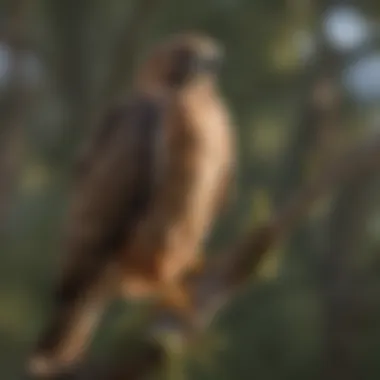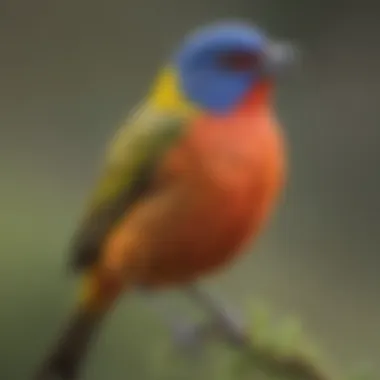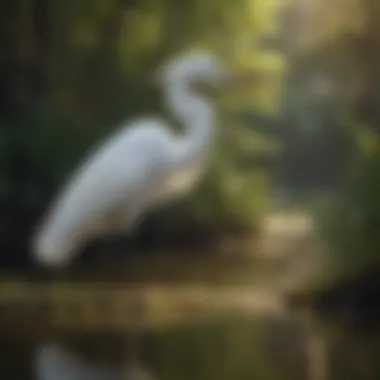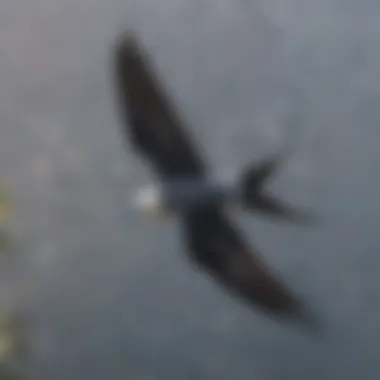Exploring the Diverse Avian World of the Southern United States


Animal Species Profile
- Introduction to the animal species The avian diversity of the Southern United States encompasses a wide array of bird species, from majestic raptors to colorful songbirds. Each species has its own unique characteristics that contribute to the vibrant tapestry of bird life in the region.
- Physical characteristics and appearance Birds in the Southern United States display a remarkable range of physical traits, from the sleek, streamlined bodies of hawks and falcons to the exquisite plumage of warblers and orioles. Their diverse colors, sizes, and shapes are adaptations that help them thrive in their respective habitats.
- Natural habitat and distribution These avian species inhabit diverse ecosystems across the Southern United States, including deciduous forests, wetlands, grasslands, and coastal marshes. Their distribution is influenced by factors such as food availability, nesting sites, and seasonal changes.
- Behavior and social interactions Bird behavior varies widely among species, with some being solitary while others are highly social. From elaborate mating displays to complex territorial behaviors, avian interactions offer insights into their ecological roles and social dynamics.
Introduction
The exploration of avian diversity in the Southern United States is a compelling subject that unveils the intricate tapestry of birdlife in the region. This section sets the stage for a detailed examination of the unique bird families that call the southern US home. Understanding the various bird species, their behaviors, and habitats provides a profound insight into the ecosystem dynamics and biodiversity present in this geographical area.
Overview of Avian Diversity
Importance of Bird Species
Delving into the importance of bird species sheds light on their pivotal role in the ecosystem. Birds serve as indicators of environmental health, their presence or absence reflecting changes in habitat conditions and biodiversity. Their diverse characteristics, such as foraging behaviors, nesting habits, and migratory patterns, offer valuable insights into ecosystem functioning. Highlighting the significance of bird species helps in raising awareness about conservation efforts and emphasizing the interconnectedness of all living organisms.
Migratory Patterns
The migratory patterns of birds are a marvel of nature, captivating researchers and enthusiasts alike. Understanding how birds navigate vast distances, often crossing continents, elucidates the complex phenomenon of avian migration. Migratory behavior is a survival strategy shaped by evolutionary forces, influenced by factors like food availability, seasonal changes, and breeding needs. Exploring these patterns offers a glimpse into the adaptability and resilience of avian species, showcasing their ability to traverse daunting terrains with precision and grace.
Habitats in the Southern US
The diverse habitats in the Southern United States create a mosaic of environments that support a wide array of bird species. From lush forests to coastal wetlands, each habitat type harbors its own set of avian communities with unique adaptations. Understanding the characteristics of these habitats is key to conserving the rich biological heritage of the region. Exploring the nuances of bird habitats provides insight into the ecological niches birds occupy and the crucial role they play in maintaining ecosystem balance.
Bird Families
Bird families play a crucial role in understanding the avian diversity of the Southern United States. By categorizing birds into families based on shared characteristics and genetic relationships, researchers and enthusiasts can unravel the complex web of bird life in the region. Understanding bird families provides insights into evolutionary relationships, behaviors, and ecological roles within ecosystems. It allows for a more structured approach to studying and appreciating the vast array of bird species that call the Southern US home.
Songbirds
Songbirds, a diverse group known for their melodious calls and vibrant plumage, are integral to the avian landscape of the Southern United States. They belong to varied families, each with its unique traits and adaptations. These birds play essential roles in pollination, seed dispersal, and insect control, contributing to ecosystem balance and health. Songbirds are popular among birdwatchers for their enchanting songs and beautiful colors, making them key subjects of study and admiration.
Cardinalidae
Cardinalidae, a family of passerine birds, includes iconic species like the Northern Cardinal. Known for their brilliant red plumage and melodious voices, Cardinalidae members are a favorite among bird enthusiasts. Their distinct coloration and vocalizations make them easily recognizable and sought after by both novice and seasoned birdwatchers. Cardinals' adaptability to various habitats and their presence year-round in the Southern US make them a valuable part of the avian community.


Parulidae
Parulidae, commonly referred to as New World warblers, are a diverse group of small, insect-eating songbirds. Known for their lively songs and energetic foraging behaviors, Parulidae members contribute to pest control in forests and wetlands. These colorful birds are prized for their beauty and grace, drawing attention from birdwatchers and researchers alike. However, their reliance on specific habitats and food sources makes them vulnerable to ecosystem changes and habitat loss.
Icteridae
Icteridae, a family comprising blackbirds, orioles, and meadowlarks, adds diversity to the songbird community in the Southern US. With their varied plumage colors and distinctive calls, Icteridae members bring a touch of charisma to local habitats. Their role in seed dispersal and insect control benefits ecosystems, demonstrating the interconnectedness of avian species. However, their communal roosting behaviors and reliance on specific food sources can make them susceptible to environmental disruptions.
Birds of Prey
Birds of prey, apex predators in the avian world, play vital roles in maintaining ecological balance in the Southern United States. With keen eyesight, powerful talons, and sharp beaks, these majestic birds are formidable hunters and vital components of the food chain. By controlling populations of small mammals and birds, they help regulate ecosystem dynamics, contributing to overall ecosystem health and stability.
Accipitridae
Accipitridae, a family encompassing hawks, eagles, and kites, are renowned for their soaring flights and acute hunting skills. These birds of prey are top predators in their habitats, preying on a variety of species from rodents to fish. Accipitridae's role in controlling rodent populations benefits agricultural areas and forests, reducing crop damage and maintaining wildlife balance. Their aerial displays and territorial behaviors make them both awe-inspiring and essential components of the avian ecosystem.
Falconidae
Falconidae, a family that includes falcons and caracaras, are known for their incredible speed and agility in flight. These birds of prey excel at hunting on the wing, using their sharp talons and beaks to capture agile prey like birds and insects. Falconidae's presence in the Southern US signifies a healthy ecosystem, as they require open spaces for their hunting strategies. Their aerial acrobatics and precise hunting techniques make them fascinating subjects for observation and study.
Cathartidae
Cathartidae, represented by vultures and condors, are essential avian scavengers that fulfill a unique ecological role in the Southern United States. These birds play a crucial part in recycling nutrients by consuming carrion, cleaning up the environment, and preventing the spread of diseases. Despite their less glamorous reputation, Cathartidae members are valuable members of the ecosystem, contributing to sanitation and health through their scavenging activities. Their soaring flights and communal roosting habits add an intriguing element to the avian diversity of the region.
Waterbirds
Waterbirds, adapted to aquatic habitats, thrive in the wetlands, rivers, and coastlines of the Southern United States. These birds play diverse roles in their ecosystems, ranging from fish predation to wetland conservation. Their specialized beaks, webbed feet, and waterproof plumage equip them for life in and around water, highlighting the adaptability and evolution of avian species in response to environmental challenges.
Ardeidae
Ardeidae, commonly known as herons and egrets, are elegant waterbirds characterized by their long legs, necks, and sharp bills. These birds are expert fishers, using their stealth and patience to hunt prey in shallow waters. Ardeidae's significance lies in their contribution to wetland health and equilibrium, as they regulate fish populations and forage on aquatic invertebrates. Their graceful forms and hunting techniques make them iconic symbols of wetland ecosystems in the Southern US.
Anatidae


Anatidae, encompassing ducks, geese, and swans, are versatile waterbirds that inhabit various aquatic environments in the Southern United States. Known for their seasonal migrations and distinctive vocalizations, Anatidae species play critical roles in dispersing seeds, regulating aquatic vegetation, and providing food for predators. Their adaptability to diverse habitats and ability to thrive in both freshwater and saltwater environments make them vital components of wetland ecosystems, demonstrating the resilience and flexibility of avian species.
Recurvirostridae
Recurvirostridae, a family that includes avocets and stilts, are striking waterbirds recognized for their long, slender legs and distinctive bill shapes. These birds are well-adapted to foraging in shallow waters, using their unique bills to probe for aquatic invertebrates. Recurvirostridae's presence in coastal marshes and estuaries indicates the health of these fragile ecosystems, as they are sensitive to changes in water quality and habitat degradation. Their specialized feeding behaviors and social dynamics contribute to the intricate web of life in wetland habitats of the Southern US.
Shorebirds
Shorebirds, a diverse group of avian species found along coastlines and wetlands, play essential roles in marine and estuarine ecosystems in the Southern United States. With their long bills, webbed feet, and migratory patterns, shorebirds exhibit a range of adaptations for foraging and survival in intertidal zones. Their seasonal movements and breeding behaviors are influenced by coastal habitats, tides, and food availability, showcasing the interconnectedness between avian populations and environmental factors.
Charadriidae
Charadriidae, including plovers and lapwings, are adept shorebirds known for their distinctive calls and intricate courtship displays. These birds exhibit remarkable behaviors during breeding season, engaging in territorial defense and nest protection. Charadriidae's presence on beaches and mudflats indicates the ecological health of these habitats, as they rely on undisturbed shorelines for nesting and foraging. Their sensitivity to human disturbances underscores the importance of preserving coastal areas for the conservation of shorebird populations.
Scolopacidae
Scolopacidae, a diverse family comprising sandpipers, snipes, and phalaropes, are migratory shorebirds that traverse vast distances during seasonal movements. Known for their long bills and probing foraging behavior, Scolopacidae members play critical roles in aerating soil, controlling insect populations, and dispersing seeds in coastal ecosystems. Their intricate plumage patterns and intricate behaviors add color and diversity to coastal areas, enriching the avian tapestry of the Southern US.
Haematopodidae
Haematopodidae, represented by oystercatchers, are charismatic shorebirds with distinctive red bills and vocalizations. These birds are specialized feeders, using their sharp bills to extract mollusks and crustaceans from intertidal areas. Haematopodidae's distribution along rocky coastlines and sandy shores reflects their dependence on specific habitats for foraging and breeding. Their adaptability to dynamic coastal environments and their role in controlling intertidal prey populations highlight their importance in maintaining ecosystem balance in the Southern United States.
Noteworthy Species
In this section, we delve into the significant role of noteworthy species in unraveling the avian tapestry of the Southern United States. Noteworthy species serve as key indicators and ambassadors of their ecosystems, reflecting the diversity and health of the region's habitats. By focusing on these standout avian representatives, we can gain valuable insights into the intricate interplay between bird species and their environment. Their unique characteristics and behaviors offer a window into the complexity and beauty of the avian world, making them essential subjects for study and conservation efforts.
Northern Cardinal
Physical Description
The Northern Cardinal's striking physical appearance is a focal point of admiration for bird enthusiasts across the globe. With its vibrant red plumage and prominent crest, this Cardinalidae species stands out vividly against the lush greenery of its habitat. The cardinal's distinctive coloration serves both aesthetic and practical purposes, aiding in mate attraction and species recognition. Additionally, its robust build and sharp beak enable efficient seed consumption, showcasing an evolutionary adaptation tailored for its preferred diet. Despite some challenges posed by its brilliant hues which might attract predators, the cardinal's overall physical attributes make it a resilient and charismatic symbol of avian diversity.
Habitat and Distributio


The Northern Cardinal's habitat preferences span a range of environments, from dense woodlands to urban gardens, demonstrating its adaptability to diverse landscapes. This widespread distribution across the Southern United States ensures the cardinal's presence in both natural and human-altered settings, emphasizing its versatility as a thriving bird species. Nesting in shrubs and trees, this species utilizes its surroundings effectively to establish breeding territories and raise offspring successfully. While habitat fragmentation poses threats to the cardinal's populations, its ability to thrive in varied habitats underscores its resilience in the face of environmental challenges.
Behavioral Characteristics
The behavioral repertoire of the Northern Cardinal offers a fascinating glimpse into its social dynamics and communication strategies. Known for their melodious songs and frequent vocalizations, cardinals use calls to establish territories and signal alarm in response to perceived threats. Males engage in spirited singing to attract mates and defend their territories, showcasing their dedication to reproductive success. Observing their courtship rituals and parenting behaviors reveals the intricate social structure within cardinal communities, highlighting the cooperative efforts that contribute to their survival. Despite potential conflicts with other bird species over resources, cardinals' behavioral adaptations help maintain equilibrium within their ecosystems, ensuring their continued presence amidst evolving landscapes.
Conservation Efforts
Conservation Efforts play a pivotal role in the preservation of avian species in the Southern United States. By focusing on the protection and restoration of habitats crucial to bird populations, conservation efforts aim to ensure the survival of diverse avian species for future generations. Bird conservationists work tirelessly to address key issues such as habitat loss, climate change impact, and human interference, advocating for policies and practices that promote sustainable coexistence between humans and birds. Through collaborative initiatives and public awareness campaigns, conservation efforts strive to mitigate threats to bird populations and promote ecosystem health.
Challenges Facing Bird Populations
Habitat Loss
Habitat Loss stands as a primary threat to bird populations in the Southern US, jeopardizing the delicate balance of ecosystems that birds rely on for nesting, feeding, and shelter. The conversion of natural habitats for urban development, agriculture, and other human activities disrupts bird habitats, leading to declining population numbers and reduced biodiversity. The fragmentation of habitats further isolates bird species, making them more vulnerable to predation and environmental hazards. Efforts to mitigate habitat loss include habitat restoration projects, land conservation measures, and urban planning strategies that prioritize biodiversity conservation.
Climate Change Impact
Climate Change Impact poses a significant challenge to avian diversity in the Southern United States, altering weather patterns, habitat suitability, and food availability for bird species. Rising temperatures, extreme weather events, and shifting migration patterns disrupt established ecosystems, forcing birds to adapt to changing conditions rapidly. Bird populations like migratory species face uncertainties in finding suitable stopover sites and breeding grounds due to climate-related disruptions. Conservation efforts focus on climate-resilient practices, advocacy for emission reductions, and monitoring the impact of climate change on bird populations to inform adaptive management strategies.
Human Interference
Human Interference emerges as a critical factor affecting bird populations in the Southern US, with activities such as habitat destruction, pollution, and direct disturbances impacting bird behavior and survival. Urbanization encroaches on natural habitats, leading to habitat degradation and reduced biodiversity. Pollution from industrial processes and agricultural practices contaminates water bodies and food sources vital to birds, contributing to health issues and population decline. Bird-friendly practices, such as sustainable land use, responsible waste management, and minimizing light pollution, can help reduce human interference and create bird-friendly environments for diverse avian species to thrive.
Conclusion
Appreciation of Avian Diversity
Importance of Bird Conservation
As we navigate the realm of avian diversity in the southern United States, the significance of bird conservation emerges as a central tenet shaping our understanding of ecological well-being. The [Importance of Bird Conservation] manifests in its multifaceted contributions to the preservation of biodiversity, ecosystem stability, and the cultural heritage intertwined with avian species. Emphasizing the delicate interplay between human activities and avian habitats, the practice of bird conservation serves as a beacon of hope for safeguarding vulnerable bird populations and nurturing sustainable ecosystems. By advocating for the protection of endangered species, supporting habitat restoration initiatives, and promoting responsible birdwatching practices, [Importance of Bird Conservation] epitomizes a proactive approach towards sustainable cohabitation with avian life in the southern US.
Personal Engagement in Birdwatching
Future Prospects for Bird Species
Within the dynamic landscape of avian diversity, contemplating the [Future Prospects for Bird Species] unveils a realm of possibilities and challenges shaping the trajectory of avian populations in the southern United States. The adoption of sustainable land management practices, implementation of bird-friendly infrastructure, and advocacy for policy frameworks conducive to avian conservation are pivotal in shaping favorable outcomes for bird species. By envisioning a future where human-wildlife coexistence thrives, [Future Prospects for Bird Species] propels us towards a horizon brimming with hope, innovation, and harmonious interactions between avian inhabitants and human communities. Embracing technological advancements, fostering interdisciplinary collaborations, and prioritizing the conservation of critical habitats are essential components in charting a course towards a sustainable future for bird species, ensuring their longevity and resilience amidst evolving environmental challenges.







